|
1.5.4 Given a grounding that penetrates the outer hull, PB is the probability that the damage will extend into a particular cargo tank. As shown above, the probability of breaching the CO2 tank from bottom damage is 0.1452, or about 14.5%.
1.6 Calculating the mean outflow from bottom damage
1.6.1 For bottom damage, outflow is computed based on hydrostatic pressure balance, in accordance with the assumptions described in paragraph 7 of regulation 21. Independent calculations are performed for 0.0 m and minus 2.5 m tides, and then the results are combined to provide an overall mean outflow for bottom damage.
1.6.2 Per paragraph 7.3.2 of regulation 21, the cargo level after damage, measured in meters above Zl, is calculated as follows:
hc = {(ds + tc - Zl)(ρs) - (1000p)/g}/ρn
where:
ds = the load line draught = 9.0 m
tc = the tidal change = 0 m and - 2.5 m
Zl = the height of the lowest point in the cargo tank above baseline = 2.0 m
ρs = density of seawater, to be taken as 1,025 kg/m3
p = inert gas overpressure = 5 kPa
g = acceleration of gravity 9.81 m/s2
ρn = nominal density of cargo oil = 900 kg/m3
For 0.0 m tide:
hc = {(9.0 + 0.0 - 2.0)(1,025) - (1000)(5)}/900 = 7.406 m
For 2.5 m tide:
hc = {(9.0 - 2.5 - 2.0)(1,025) - (1000)(5)}/900 = 4.559 m
1.6.3 The oil outflow, OB, from each tank due to bottom damage equals the original volume (98% of tank capacity) minus the amount remaining (oil up to level hc).
Oil Outflow (m3) at
| Tank |
at 0.0 m time |
at -2.5 m tide |
CO1
CO2 |
5,471
16,413 |
6,993
20,979 |
|
1.6.4 In accordance with paragraphs 7.1 and 7.2 of regulation 21, the mean outflow from bottom damage is calculated as follows:
1.6.5 It is recognized that a portion of the oil escaping from a cargo tank may be entrapped by a double bottom tank below, thereby preventing the oil from reaching the sea. In accordance with paragraph 7.4 of regulation 21, CDB(i) is to be taken as 0.6 when a cargo tank is bounded from below by a non-oil compartment.
1.6.6 The mean outflow from bottom damage without tidal change is:
| Tank |
PB(i) |
OB(i) (m3) |
CDB(i) |
OMB(i) (m3) |
CO1
CO2 |
0.0348
0.1452 |
5,471
16,413 |
0.6
0.6 |
114
1,430 |
| OMB(0) =1,544 |
|
1.6.7 The mean outflow after a 2.5 m reduction in tide is:
| Tank |
PB(i) |
OB(i) (m3) |
CDB(i) |
OMB(i) (m3) |
CO1
CO2 |
0.0348
0.1452 |
6,993
20,979 |
0.6
0.6 |
146
1,828 |
| OMB(2.5) =1,974 |
|
1.6.8 In accordance with paragraph 5.2 of regulation 21, mean outflow values from the 0.0 m and -2.5 m tide conditions are combined in a 70%:30% ratio to obtain the bottom damage mean outflow:
OMB = 0.7 OMB(0) + 0.3 OMB(2.5) (m3)
OMB = (0.7)(1,544) + (0.3)(1,974) = 1,673 m3
1.7 Calculating the mean outflow parameter
1.7.1 In accordance with paragraph 5.1 of regulation 21, the mean outflow from side damage and bottom damage are combined in a 40%:60% ratio and then this value is divided by the total oil volume C to obtain the overall mean outflow parameter:
OM = (0.4 OMS + 0.6 OMB)/C
OM = [(0.4)(4,172) + (0.6)(1,673)]/3,721 = 0.071
1.7.2 The final step in the evaluation of an actual oil tanker is to compare the calculated value of OM with the maximum permissible value given in paragraph 3.1 and regulation 21.
2 VLCC example
2.1 General Data
L : 321.10m (length as defined in regulation 1.19)
ds : 21.20 m (moulded load line draught)
dB : 8.865 m (moulded draught corresponding to 30% of the depth Ds)
Bs : 60.00 m (the greatest moulded breadth at the deepest load line ds)
BB : 60.00 m (the greatest moulded breadth at the waterline dB)
Ds : 29.55m (moulded depth)
DW : 300,000 ton (deadweight as defined in regulation 1.23)
C : 333,200 m3 (total volume of cargo oil at 98% tank filling)
Figure 27 - Tank Arrangement
Figure 28 - Side Damage
(No.1 COT (Fr.96 - Fr.106))
|
(拡大画面:38KB)
|
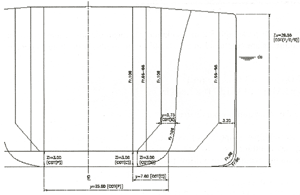 |
Figure 29 - Side Damage
(Nos.2,3,4 Cot (Fr.66-Fr.96))
|
(拡大画面:23KB)
|
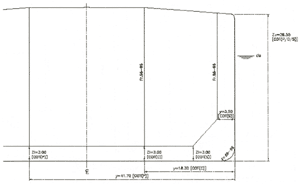 |
Figure 30 - Side Damage
(No.5 COT & SLOP (Fr.56-Fr.66))
|
(拡大画面:32KB)
|
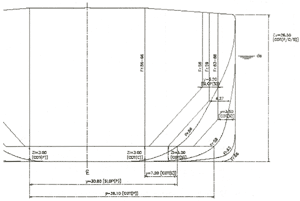 |
Figure 31 - Bottom Damage
(No.1 COT (Fr. 96-Fr. 106))
|
(拡大画面:54KB)
|
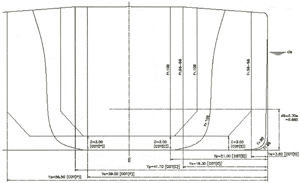 |
Figure 32 - Bottom Damage
(Nos.2,3,4 COT (Fr.66-Fr.96))
|
(拡大画面:44KB)
|
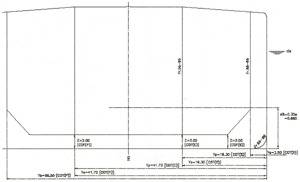 |
|